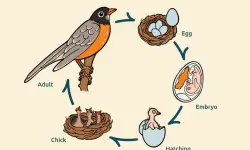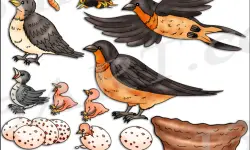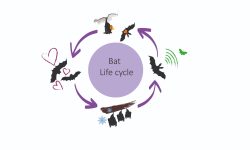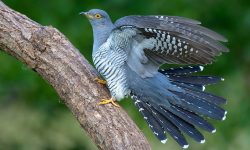When people imagine the Hawaiian Islands, they picture white sand beaches, lush rainforests, and colorful tropical birds. But high above the waves and treetops, a different class of avian beauty sometimes soars—falcons. Though not native to the islands, a few species of these swift, powerful raptors have been spotted gracing Hawaii’s skies. In this article, we explore the top 3 rare falcons in Hawaii, how they got here, and the best places and times to spot them.
Are Falcons Native to Hawaii?
Falcons are part of the Falconidae family, within the order Falconiformes, a group of diurnal birds of prey known for their speed and precision hunting. Unlike the endemic ʻIo (Buteo solitarius), Hawaii’s native hawk, falcons are not native to the Hawaiian archipelago.
Due to Hawaii’s extreme geographic isolation—over 2,000 miles from the nearest continent—few raptors naturally colonized the islands. However, some falcons do occasionally arrive as vagrants or winter visitors, either blown off course during migration or following prey populations across the Pacific.
1. Peregrine Falcon (Falco peregrinus)
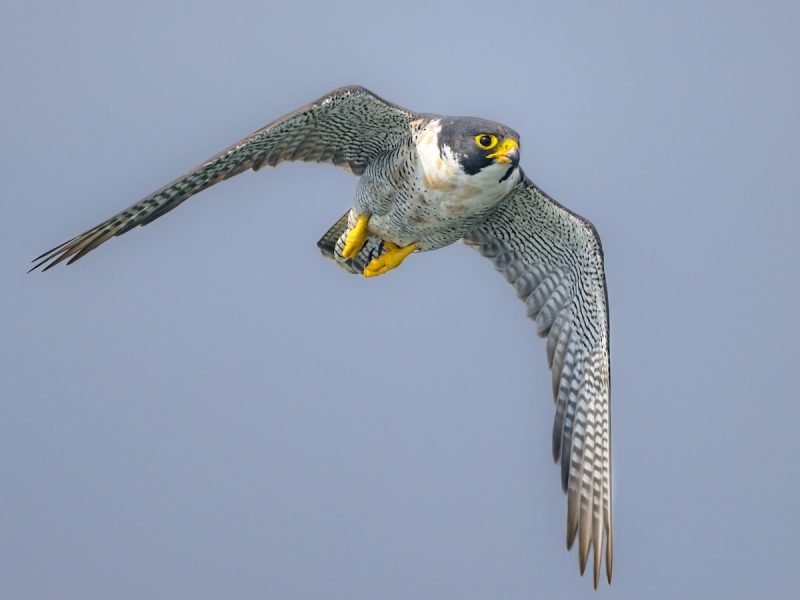
Status in Hawaii
Among the rarest aerial visitors to Hawaii, the Peregrine Falcon graces the islands only during the cooler months. Though not a permanent resident, it appears as an uncommon migrant and winter visitor, particularly between October and March. Sightings are most likely on the larger islands—Oʻahu, Maui, and Hawaiʻi Island—where a mix of wetlands and coastal ecosystems offers ideal hunting grounds.
Identification
Sleek, lethal, and breathtakingly fast, the Peregrine Falcon is not only the most widespread falcon species on Earth—it holds the title of the fastest animal alive. During its signature hunting dive, known as a stoop, it can plummet from the sky at speeds exceeding 240 miles per hour (386 km/h), turning its body into a feathered missile.
Visually, this raptor exudes power and elegance. Adults display a striking blue-gray back, sharply barred white underparts, and a bold dark facial mask—often referred to as a “helmet”—that gives it a fierce, gladiator-like look. The wings are long and pointed, built for speed, and when perched, the bird’s silhouette is clean, compact, and alert.
Behavior and Occurrence
Peregrines are skyborne predators, evolved for speed and precision. Their primary prey is other birds, which they often strike mid-air in a sudden burst of speed. In Hawaii, they are most commonly observed hunting over coastal wetlands, where migratory shorebirds and seabirds gather in dense flocks—an ideal buffet for a raptor that prefers fast, agile targets.
Though sightings are rare, the presence of a Peregrine Falcon is unmistakable: a blur of motion, followed by an explosion of panicked birds rising from the shoreline. They often patrol coastlines and open skies in search of movement, using high vantage points like cliff edges, utility poles, or tall trees to survey the landscape below.
Best Places to Spot in Hawaii
If you’re hoping to witness this aerial hunter in action, you’ll want to visit areas where land and sea meet—a perfect hunting zone for Peregrines. Some of the best locations include:
Keaīwa Heiau State Park (Oʻahu): Look toward the skies or distant ridgelines in the late afternoon.
Keaʻau Coastline (Hawaiʻi Island): Open ocean views and rocky shores provide excellent hunting grounds.
Kanaha Pond State Wildlife Sanctuary (Maui): Shorebirds gather here in numbers, sometimes attracting this high-speed hunter.
Watch the skies with patience, and scan high perches for a still, watchful shape. If you’re lucky, you’ll catch a silhouetted falcon carving through the clouds, or witness a stoop that blurs the boundary between bird and bullet. In Hawaii, few wildlife encounters feel as thrilling—or as rare—as crossing paths with a Peregrine Falcon.
2. Merlin (Falco columbarius)
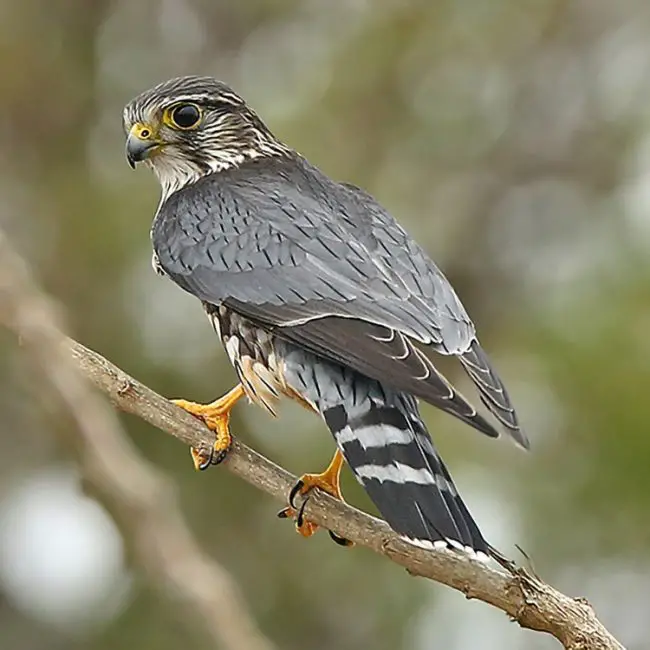
Status in Hawaii
The Merlin is a ghost of the skies in Hawaii—a rare vagrant whose appearance is both unexpected and electrifying. Typically recorded only a few times per decade, this small falcon occasionally arrives in the islands after being blown far off its migratory path. These brief visits, often in the late fall and early winter, are the stuff of legends for Hawaii’s birding community, who watch for it with quiet hope and sharp binoculars.
Identification
Don’t let its small size fool you. The Merlin is a compact, muscular predator built for ambush and acceleration. Shorter and stockier than a Peregrine Falcon, it sports a broad chest, short tail, and robust wings that lend it a blunt, powerful silhouette in flight.
Plumage can vary depending on subspecies—individuals that reach Hawaii may come from Alaska, Canada, or even further afield. Generally, they appear dark slate or brownish-gray above, pale below, with dense, vertical streaking on the breast. Their face lacks the dramatic “helmet” of a Peregrine, but often shows a soft mustache line and sharp, determined eyes.
A Merlin’s flight is fast and purposeful, often hugging the landscape in a blur of focused intent.
Behavior and Occurrence
In their native range, Merlins are fierce aerial hunters, specializing in the pursuit of small songbirds, shorebirds, and even bats. Unlike larger falcons that stoop from above, Merlins often hunt horizontally, chasing prey in hot pursuit like a jet fighter locked on target.
In Hawaii, they appear only as accidental visitors—likely carried off course by storms or strong weather patterns during migration. Their arrival usually coincides with the peak migratory season between October and January, when the Pacific sees the movement of millions of birds across long distances.
Though they don’t linger long, Merlins can sometimes be seen for a few fleeting days or weeks—often perching on telephone poles, coastal branches, or patrolling wetlands at low altitude.
Best Places to Spot in Hawaii
While there are no guaranteed locations to see a Merlin in Hawaii, a few refuges and open areas have produced credible sightings:
James Campbell National Wildlife Refuge (Oʻahu): A haven for shorebirds, this coastal wetland sometimes hosts surprise raptor guests.
Hanalei National Wildlife Refuge (Kauaʻi): Vast open space and rich avian life make it a potential Merlin magnet.
Kīlauea Point National Wildlife Refuge (Kauaʻi): Cliffs, seabird colonies, and panoramic views create ideal scanning conditions for transient raptors.
Merlin encounters in Hawaii are fleeting and silent. Often, you’ll only notice a blur sweeping low across the marsh, scattering smaller birds into the air. Or you might spot a compact falcon, quietly perched, eyes scanning for movement, ready to spring into action at a moment’s notice.
Seeing one is a rare privilege. It’s not just spotting a bird—it’s glimpsing the improbable path of a wind-riding predator that crossed thousands of miles to touch the edge of paradise.
3. American Kestrel (Falco sparverius)
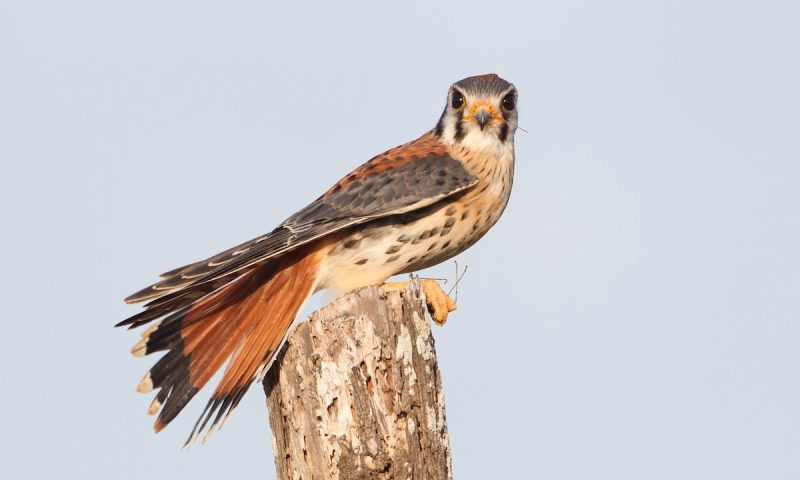
Status in Hawaii
In the realm of Hawaii’s birdlife, the American Kestrel is an elusive gem—an extremely rare vagrant, with only a handful of confirmed sightings across the islands. These occurrences are so unusual that each one becomes a moment of excitement for the local birding community, a flash of color and motion where no one expected it. When a kestrel appears in Hawaii, it’s not just a record—it’s an event.
Identification
As the smallest falcon in North America, the American Kestrel may be tiny, but it is anything but ordinary. This raptor is a brilliant burst of color in the sky, dazzling even at a distance. The male is a painter’s palette: a powdery blue-gray head and wings, a rich rufous back and tail, and a delicately spotted white breast. Black markings frame its face in a fierce, masked expression. The female trades some of that flash for earthier tones—warm brown plumage with dark barring on the back and tail—but she retains the kestrel’s signature elegance and alert stare.
Their flight is buoyant and active, and one of their most distinctive behaviors is hovering midair, wings fluttering rapidly as they scan the ground below for prey. It’s a silhouette hard to forget—a tiny falcon, frozen in the air like a hummingbird on the hunt.
Behavior and Occurrence
Kestrels are versatile and highly adaptable hunters, preying on everything from grasshoppers and beetles to small mammals and lizards. In open fields and along roadsides across the mainland, they are common—often seen perched on wires or fluttering above a pasture. But in Hawaii, where they have no established population, their appearance is likely the result of accidental long-distance dispersal, perhaps carried by strong trade winds or storm systems from California, Arizona, or northern Mexico.
When they do arrive, they tend to gravitate toward habitats that resemble mainland grasslands—open, dry, sparsely vegetated areas that allow them clear views and easy access to prey.
Their presence, while brief and unpredictable, serves as a powerful reminder of nature’s unpredictability. These birds are survivors, travelers, and opportunists—just daring enough to touch the edges of the Pacific.
Best Places to Spot in Hawaii
While sightings are few and far between, some locations have offered glimpses of this tiny predator:
Kahuku Agricultural Lands (Oʻahu): Open fields and minimal development make this area one of the best bets.
Leeward grasslands on Hawaiʻi Island or Maui: The dry, flat terrain here resembles the kestrel’s typical mainland haunts.
Abandoned airfields and weedy lots: Wide visibility and tall perches provide ideal conditions for scanning and hunting.
In Hawaii, the sighting of a kestrel sends ripples through the birding community. It’s the kind of encounter that turns a casual walk into a heart-pounding memory. A flicker of russet and blue, a hover above the cane grass, a sharp downward dive—and just like that, it’s gone.
To glimpse an American Kestrel in Hawaii is to witness a rare crossing of worlds, where a continental predator brushes wings with a volcanic archipelago. It’s unexpected, fleeting, and utterly unforgettable.
Why Are Falcons So Rare in Hawaii?
The absence of native falcons in Hawaii is a result of several ecological and evolutionary factors:
Isolation: Hawaii’s extreme remoteness made natural colonization by large, continental raptors unlikely.
Lack of large prey populations: Prior to human arrival, Hawaii had no terrestrial mammals and few bird species suitable as prey for falcons.
Competition with native predators: The native ʻIo fills the niche of top aerial predator.
Today, occasional falcon sightings are due to accidental migration events, storm displacement, or range expansion behaviors.
Conservation Note
Though these falcons are not threatened in Hawaii, they are affected by global threats such as habitat loss, pesticides, and climate change. In particular:
The Peregrine Falcon once suffered massive population declines due to DDT, but has recovered thanks to conservation.
The Merlin and American Kestrel are declining in parts of their native range due to changes in land use and pesticide exposure.
Every sighting in Hawaii provides researchers with valuable insight into long-distance dispersal and climate-related movement patterns.
Conclusion
While Hawaii may not be a falcon stronghold, the rare appearances of Peregrine Falcons, Merlins, and American Kestrels add a thrilling dimension to birdwatching in the islands. Whether you’re scanning the skies over wetlands or watching the open coastlines, keep your binoculars ready—you just might spot a rare and powerful visitor from the skies.
Next time you’re out exploring Hawaii’s wild places, remember: falcons may be rare here, but their sudden appearance is unforgettable.

